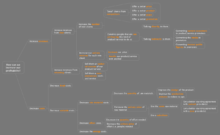Issue tree

An issue tree, also called logic tree, is a graphical breakdown of a question that dissects it into its different components vertically and that progresses into details as it reads to the right.[1]:47
Issue trees are useful in problem solving to identify the root causes of a problem as well as to identify its potential solutions. They also provide a reference point to see how each piece fits into the whole picture of a problem.[2]
There are two types of issue trees, diagnostic ones and solution ones, according to professor of strategy Arnaud Chevallier.[3]
Diagnostic trees break down a "why" key question, identifying all the possible root causes for the problem. Solution trees break down a "how" key question, identifying all the possible alternatives to fix the problem.
Four basic rules can help ensure that issue trees are optimal, according to Chevallier:[3]
- Consistently answer a "why" or a "how" question
- Progress from the key question to the analysis as it moves to the right
- Have branches that are mutually exclusive and collectively exhaustive (MECE)
- Use an insightful breakdown
The requirement for issue trees to be collectively exhaustive implies that divergent thinking is a critical skill.[4]
See also
References
- ↑ Chevallier, Arnaud (2016). Strategic thinking in complex problem solving. Oxford; New York: Oxford University Press. doi:10.1093/acprof:oso/9780190463908.001.0001. ISBN 9780190463908. OCLC 940455195.
- ↑ "Strategy survival guide: Issue trees". interactive.cabinetoffice.gov.uk. London: Prime Minister's Strategy Unit. July 2004. Archived from the original on 2012-02-17. Retrieved 2018-10-06. Also available in PDF format.
- 1 2 Chevallier, Arnaud (2 July 2010). "Build issue trees: diagnosis trees and solution trees". powerful-problem-solving.com. Retrieved 2018-10-06. See also: Chevallier, Arnaud (14 December 2010). "Be insightful". powerful-problem-solving.com. Retrieved 2018-10-06.
- ↑ Chevallier, Arnaud (6 July 2010). "Diverge effectively in your thinking". powerful-problem-solving.com. Retrieved 2018-10-06.
Further reading
- Chevallier, Arnaud (11 April 2011). "Don't get lost in the terminology". powerful-problem-solving.com. Retrieved 2018-10-06.
Issue trees, issue maps, logic trees, how trees, why trees, diagnostic trees, solution trees, decision trees, fact trees, hypothesis trees... How should you call your trees?... Call your tree what you want it to do.
- Chevallier, Arnaud (19 February 2011). "Use your issue tree as a decision tree". powerful-problem-solving.com. Retrieved 2018-10-06.
- Culmsee, Paul; Awati, Kailash (2013) [2011]. "Visualising complexity". The heretic's guide to best practices: the reality of managing complex problems in organisations. Bloomington: iUniverse, Inc. pp. 159–167. ISBN 9781462058549. OCLC 767703320.
